Resting her phone on a stand and making the light more suitable, 49﹣year﹣old Lyu Min started her livestreaming session﹣her daily job during the COVID﹣19 outbreak.Dressed in a qipao, a traditional Chinese dress, Lyu started the livestreaming session from her workshop at 10 in the morning, sharing the art of making Chinese knots with many handicraft (手工艺) lovers. Lyu, an inheritor (继承人) of the art of making Chinese knots, which is listed as an intangible (非物质) cultural heritage, became a livestreaming host.
"Though the sales of Chinese knots have dropped a lot, I'm still confident that I can get out of the trouble brought by the outbreak. I can make full use of this period to improve my skills and develop this traditional handicraft online," she said. Lyu is quite new to the world of livestreaming, having bought all the necessary equipment (设备) after following her friends advice. She practises livestreaming every day and records a large number of educational videos. As face﹣to﹣face interaction is still impractical for many, even as the outbreak has been largely brought under control in China, she thinks livestreaming classes can meet more Chinese knot lovers' needs to learn the handicraft.
She has integrated the anti﹣epidemic spirit into her works, expressing the determination (决心) and confidence of the Chinese people to win against the COVID﹣19. "I love Wuhan, where I showed my works in 2019. Chinese knots are popular among many local people, and I made lots of friends there," Lyu said. She designed a special Chinese knot to express her thanks to the medics who were sent to support Wuhan several months ago.
She has more than 200 followers right now. There are more and more Chinese knot lovers on her online platform. She is using a length of colored string and determination to keep this traditional art of Chinese knots alive online and help more people understand the culture.
(1)The underlined word "livestreaming" in Paragraph 1 is close to " ".
A. sending out while happening
B. equipment for recording videos
C. sending out after recording
D. equipment for making handicrafts
(2)Which of the following is true according to the passage?
A. Lyu Min advised her friends to livestream traditional handicraft online.
B. Lyu Min's friends provided the necessary equipment for her to livestream.
C. Chinese knots sell very well in Lyu Min's workshop through the Internet.
D. More Chinese knot lovers want to learn the handicraft because of Lyu Min.
(3)What does Lyu Min think of the future of Chinese knots?
A. Unexpected.
B. Hopeful.
C. Difficult.
D. Doubtful.
(4)What's the best title for the passage?
A. Having online classes during the outbreak
B. Introducing an intangible cultural heritage
C. Livestreaming the art of making Chinese knots
D. Expressing thanks to the doctors and nurses

Katie Steller has her own salon (美发院). She often wheels her red chair and scissors around the city to give free haircuts.
Edward was her first lucky customer. He looked to be in his 60s. He was balding and missing a few teeth. While she was cutting his greying hair, he told her about moving closer to his adult children.
Till now, Steller has offered about 30 such haircuts. These people are all living a hard time, and she is aware of the power of her cleanup job.
"It’s more than a haircut," she says. "I want it to be a gateway, to show value and respect, but also to get to know people. I want to build relationships. "
Steller knows that a haircut can change a life. As a teen, she had a very serious disease and her hair thinned terribly. Her mother took Steller for her first professional haircut.
"To sit down and have somebody look at me and talk to me like a person and not just an illness, it helped me feel cared about and less alone," she says.
After that, Steller knew she wanted to have her own salon so she could help people feel the way she’d felt that day. In 2019, she began her Red Chair Project.
She says, "I can’t fix their problems with free haircuts,but maybe I can help them feel less alone for a moment."
Early this year she started the Steller Kindness Project, in which people who do acts of kindness (volunteering for snowstorm relief, helping neighbors in need) are invited for a free haircut at Steller’s salon. In exchange, they tell their stories, which Steller shares on her website. Her hope is that by reading about kind acts, others will spread their own.
So far Steller has had people reach out from around the country.
(1)Why did Steller start her Red Chair Project?
A. To help her neighbors in need.
B. To attract customers to her salon.
C. To help the lonely people feel less alone.
D. To invite customers to tell their kind acts.
(2)What does Steller mean by the sentence "It’s more than a haircut" in Paragraph 4?
A. A haircut can fix people’s problems.
B. A haircut is what people need most.
C. Haircut stories are well reviewed on her website.
D. A haircut is a simple act to show care, value and respect.
(3)Which best describes Katie Steller?
A. Lonely and inactive.
B. Kind and thoughtful.
C. Doubtful and generous.
D. Serious and careful.
(4)Which sentence best expresses the theme of the story?
A. Simple acts of kindness like a free haircut will spread.
B. Haircuts need practice and practice makes perfect.
C. It’s heartbreaking to see how lonely people look.
D. We can win great respect by giving free haircuts.
One cannot discuss Chinese music without mentioning the guqin,one of the four arts-along with game of go,calligraphy(书法)and painting.It first appeared over 3,000 years ago and stands for China's solo musical instrument tradition.
At first,the guqin had only five strings(弓玄),meaning the five elements(元素)of metal,wood,water,fire and earth.Later,in Zhou Dynasty,King Wen of Zhou added a sixth string for his son.King Wu of Zhou,added a seventh string to encourage his army to fight with the Shang.
Ambiencewas important in playing the guqin.Usually,it was practiced in a quiet setting and never for public performance.Ancient artists enjoyed performing by a stream in the mountains.The sound of the guqin mixed with the echoes(回音)from the mountains,until the musician felt he was at one with nature.Playing it in snow was also an enjoyable activity for ancient artists,who believed the instrument was the purest of its kind in the world.Also,a night with moonlight was considered wonderful for playing the guqin.Wang Wei(701-761),a highly talented man of the Tang Dynasty,liked playing it in a bamboo forest on nights with moonlight most.
Guqin pieces are usually three to eight minutes long,with the longest being Guangling Verse,which is 22 minutes long.Other famous pieces include Plum Blossoms in Three Movements,Wild Geese Landing on the Sandbank and Eighteen Songs of a Nomad Flute.
Nowadays,there are fewer than one thousand well﹣trained guqin players and perhaps no more than fifty living masters.The original number of several thousand pieces has greatly reduced to only one hundred works by today.The guqin and its music was added to the list of the Intangible Cultural Heritage of Humanity(人类非物质文化遗产)in 2003.
(1)Today,the guqin has strings.
| A. |
four |
| B. |
five |
| C. |
six |
| D. |
seven |
(2)What's the meaning of the underlined word "Ambience" in Paragraph 3?
| A. |
演奏技巧. |
| B. |
环境氛围. |
| C. |
天气状况. |
| D. |
弹奏曲目. |
(3)According to the passage,playing the guqin is a right choice.
| A. |
at a quiet restaurant |
| B. |
at a welcome party |
| C. |
in a peaceful yard with flowers |
| D. |
on a dark night with rainstorm |
(4)According to the passage,which of the following is TRUE?
| A. |
The guqin has a history of less than 3000 years. |
| B. |
The strings mean metal,wood,water,fire and stone. |
| C. |
The longest guqin piece is Guangling Verse. |
| D. |
The guqin is very popular and many people can play it. |
(5)What does the passage mainly talk about?
| A. |
The guqin and its music. |
| B. |
The guqin and its players. |
| C. |
Four Chinese traditional arts. |
| D. |
The development of guqin music. |
20,000 local sea creatures,from dolphins to otters(水獭), await you at Aquarium(水族馆)of the Bay, San Francisco, CA(California). When you see a river otter in the wild, you know that water system is healthy. Plus, they’re fun to watch! Here come the Aquarium’s popular and lovable river otters:Tahoe, Ryer and Shasta.
|
|
Me: I was born at the Oakland Zoo. I'm the halfbrother of Ryer. February 20, 2016 is my birthday and I joined the Aquarium,s river otter family in January, 2017. I'm named after Lake Tahoe, CA. How to find me: My fur is reddish in color. I am the youngest but the longest of the group. Hobbies: I enjoy playing with rope and toys, running and jumping around. |
|
|
Me: I'm a male river otter named after Ryer Island,CA.I was born in February,2013 at the Oakland Zoo and joined the Aquarium's otter team in 2014. How to find me: I have the widest head and the fattest face. Hobbies: What could be more fun than playing with my food and balancing rocks, and curling up with a warm blanket for a nap (a short sleep)?We river otters can sleep up to 18 hours a day. |
|
|
Me: I'm a 7yearold male river otter named after Mount Shasta, CA. I was saved from the fur trade in Louisiana and found a new home at the Aquarium in 2013. How to find me:I'm the largest of the otters.I have large closeset eyes.Which of the three is me? Hobbies: I enjoy long afternoon naps, throwing leaves and sticks into the water. |
(1)The passage mainly talks about .
A. how to play with the otters in the zoo
B. how to protect river otters in the wild
C. the importance of protecting river otters
D. the river otter family at Aquarium of the Bay
(2)Which of the following is TRUE about Ryer?
A. He was born in February, 2014.
B. He has large closeset eyes.
C. He is the halfbrother of Tahoe.
D. His fur is reddish in color.
(3)What do the three otters have in common?
A. They are all named after a place in California.
B. They were all born at the Oakland Zoo.
C. They can sleep at most 8 hours a day.
D. They enjoy playing with food and rocks.
Marianne Carus,who started Cricket(蟋蟀)magazine in 1973 and served as Editor﹣in﹣Chief(总主编)until 2012,died on March 3 at the age of 92 this year.
Marianne believed that "only the best of the best is good enough for the young. "In Cricket,children would find wonderful stories with beautiful art,and be encouraged by ideas in the humanities and sciences.Marianne looked for stories from around the world to awaken admiration for different peoples and cultures.Most important,Cricket would never talk down to children.
Marianne knew that children were filled with fun,and she wanted Cricket to be,too - "humor from the heart that makes you laugh out loud. "And so she named her literary magazines after a funny group of bugs(虫子),such as Lady bung and Spider.
Over the years,Cricket has been read by millions of children and given many writers and artists their start.Marianne kept a special box of "love letters" to the magazine.She treasured these letters from Cricket readers,including long﹣ago readers.They told her that their interest in reading had begun with Cricket.
▲She considered other names,such as Troubadour or Taliesin,the singers and storytellers of old who traveled from one place to another to share their songs and stories.Then,one night,she was reading Isaac Bashevi Singer's memoir(回忆录)A Day of Pleasure,about his childhood in Warsaw.In it he wrote:There was a stove in Shosha's apartment behind which there lived a cricket.It chirped the nights through all winter long I imagined the cricket was telling a story that would never end. "That's exactly what Marianne wanted her children's magazine to do-to tell stories that would never end!So the name Cricket became her best choice.
Thank you for everything,Marianne.May the stories,and the laughter,never end!
(1)Cricket is a magazine most probably for .
| A. |
writer |
| B. |
children |
| C. |
artists |
| D. |
teachers |
(2)According to the passage,Marianne .
| A. |
made an effort to find the best stories |
| B. |
raised many bugs as her pets |
| C. |
replied to long﹣ago Cricket readers |
| D. |
started Cricket 39 years ago |
(3)Which of the following can be the best to fill in" ▲"in Paragraph 5?
| A. |
How was the life of crickets? |
| B. |
When was the magazine Cricket born? |
| C. |
What did Marianne think of crickets? |
| D. |
Why did Marianne name her magazine Cricket? |
(4)The best title for the passage can probably be .
| A. |
The Life of a Cricket |
| B. |
Admiration for Different Cultures |
| C. |
Best Stories for the Young |
| D. |
Achievements in Marianne 's Life |
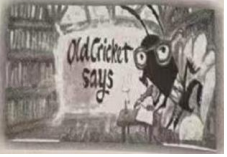
All about Electric Cars
Electric vehicles (电动车辆) have been around for more than a hundred years.But they have really been liked by a large number of people over the last ten years.More than three million all﹣electric cars,trucks,and vans are now on the road worldwide.
Helping the Environment
Most cars run on gasoline (汽油).Burning gasoline and other fossil fuels(物燃料)produces greenhouse gases.Electric vehicles don't burn gasoline.Instead,strong batteries nun their electric engines.So,electric vehicles don't directly produce greenhouse gases.
Poop Power!
Electric vehicles are better for the environment. But they are not perfect. Their batteries often use electricity (电) that was made by burning fossil fuels. But an electric vehicle uses less energy than a vehicle that runs on gasoline. Plus, some of the electricity comes from "greener" sources,such as solar and wind power. And some may soon come from a new source﹣cow poop(牛粪)!
An electric car company has worked together with a large dairy farm. They plan to make electricity using a greenhouse gas from cow poop.
Always Improving
One of the problems for electric vehicles is their limited range. This is how far they can travel before their batteries need another charge (充电). But now their range is improving. Some new electric vehicles can travel almost three times as far as older ones did. Another problem is finding a place to recharge the batteries. But the number of charging stations is going up as well, China now has thousands more charging stations than it did ten years ago. In Sweden, engineers have even designed a road that will charge electric vehicles as they drive along.
(1)Which of the following truly describes electric vehicles according to Paragraph 1?
A. Useless.
B. Popular.
C. Cheap.
D. Perfect.
(2)What does the picture above show?
A. Parts of an electric car.
B. Ways of driving a car.
C. Wheels on an electric car.
D. Batteries in an electric car.
(3)How does the electric car company plan to make electricity according to Paragraph 3?
A. By burning gasoline.
B. By burning fossil fuels.
C. By using a gas coming from cow poop.
D. By using solar and wind power.
(4)What is the last paragraph mainly about?
A. Reasons for buying new electric cars.
B. Importance of electric cars in our life.
C. Ways to produce more electric vehicles.
D. Problems and improvements of electric vehicles.
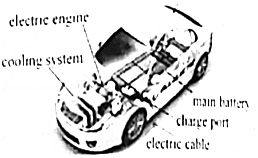
In the Spring and Autumn period (475 ﹣ 221 BC) there lived a man called Ji Zha.He was the fourth son of the king of the Kingdom of Wu.Because of Ji Zha's sticking to righteousness(正义)and wide learning,he was his father's favorite and the king wanted to make him his heir(堆承人).However,Ji Zha refused because he thought the king's eldest son should be the one to receive the throne.Later,Ji Zha served as an ambassador(外交大臣) of Wu to other kingdoms in China.
Once,on a mission to the Kingdom of Lu,Ji Zha passed through the Kingdom of Xu.The king of Xu received him as a friend,and admired the valuable sword(剑) Ji Zha was wearing.Although his host didn't mention it,Ji Zha could see he wanted to own it very much.However,as he still needed to go to Lu,Ji Zha didn't give the king of Xu his sword as a present.
After finishing his mission to Lu,on his way back,Ji Zha once again passed through Xu.This time he decided to give the sword to the king of Xu.But when he arrived,his friend had already passed away.Ji Zha didn't expect it and felt very sad.He took off his sword and gave it to the dead man by hanging it on a tree near his tomb(坟墓).
Ji Zha's attendants (随从)didn't understand his action,saying, "Sir,the king of Xu is already dead.Why do you still give up your sword to him? "
Ji Zha shook his head, "When I came to the Kingdom of Xu last time,I noticed that my friend admired my sword and I decided that when I came back I would give it to him.However,I never expected this turn of events.But how could I change my mind just because the man had died?" With these words,he left the place,low﹣spirited and heart﹣broken.
(1)What do we know about Ji Zha from the passage?
A.He was born in 221 BC.
B.He didn't have the ability to be a king.
C.He was a careful and generous man.
D.He lost his fight for the throne to his brother.
(2)Why did Ji Zha give up his sword to the king of Xu although he had died?
A.He was loyal to his country.
B.He was loyal to righteousness.
C.He wan guilty of his friend's death.
D.He was guilty of not seeing his friend before his death.
(3)What is the best title of this story!
A.Ji Zha and His Friend.
B.Ji Zha and His Country.
C.Ji Zha Gives Up His Throne.
D.Ji Zha Gives Up His Sword.
Tangchang,a town in Chengdu,is well﹣known for cloth shoes.With over 20 types,Tangchang cloth shoes are strong,comfortable,breathable and friendly to the environment.In 2018,they were added to Sichuan's intangible cultural heritage list(非物质文化遗产名录).
63﹣year﹣old Lai Shufang has spent over 40 years making Tangchang cloth shoes.Now she is a master.She said there are 32 steps to make a pair,but the most important step is making the soles.
Layers(层)of white cloth are glued together with flour paste(糨糊). "To make good paste,we make it at a temperature of 85℃.If it's too low or too high,the paste will not work, "Lai said.Then the pasted layers are dried and cut into different shapes.After this,the layered cloth is beaten again and again until it is tight(紧实的)enough to make soles and upper parts.The next step is to shape the two parts and glue them together.But still the soles' edges look fluffy.Through repeated polishing and trimming,the fluffy edges(毛边)will become smooth.Then the cloth shoes are ready.
Lai's hard work touched her son Ai Peng.In 2015,Ai decided to leave his job and help his mother.He used Shu embroidery to make the shoes look more beautiful and opened a cloth shoe store online.He also set up shop windows to show the steps of making shoes,helping more people learn about the art of cloth shoes.
(1)What is the most important step in making Tangchang cloth shoes according to Ms.Lai?
A.Making the soles.
B.Making the upper parts.
C.Making good flour paste.
(2)What is the correct order of the following steps of making Tangchang cloth shoes?
①beating the layered cloth.
②making flour paste at an exact temperature.
③gluing the upper pars and the soles together.
A. ③②①
B. ②③①
C. ②①③
(3)How many things has Lai's son done to make the cloth shoes more popular?
A.Two.
B.Three.
C.Four.
(4)Which of the following questions is answered in the passage?
A.What are the features of Tangchang cloth shoes?
B.When did Ms.Lai become a master of cloth shoes?
C.What's the most important material in making cloth shoes?
(5)What is the best tile for this passage?
A.A Talented Shoemaker,Lai Shufang
B.Hand﹣made Cloth Shoes in Tangchang
C.Tangchang,a Well﹣known Town in Chengdu
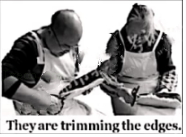
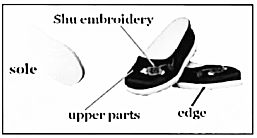
British adventurer(冒险家) Alastair Humphreys had ridden his bike around the world,walked cross India,and rowed (划船)from Africa to South America.In 2011,however,Humphreys had some of the biggest adventurers of his life﹣and he never even left the United Kingdom.
For a year,Humphreys went on microadventures ﹣ small,low﹣cost trips close to home.Why did he do this? "I started to think that it was possible to have an adventure anywhere." He explains.For his first trip,he went hiking with a friend around the M25﹣a 188﹣kilometre road that goes all the way around London.Other adventures included swimming in the River Thames,sleeping outside on a hill,and going on a mountain biking trip.Humphreys learned something important from his microadventures:We find adventures when we try something new.
Humphreys wanted other people to make this discovery,too,so he decided to share his idea.He challenged people to go on microadventures and send him four﹣minute videos of their trips.He asked them to do things like climb a hill,go away for a weekend,or choose a random (任意的)place on a map and go there.People from all over the world accepted his challenge and posted their videos on Twitter.
(1)Which of the following belong to microadventures?Check and choose the right answer.
①Walk across India.
②Sleep outside on a hill.
③Go away for a weekend.
④Swim in the River Thames.
⑤Row from Africa to South America.
⑥Hike around the road around London.
| A. |
①③④⑤ |
| B. |
①④⑤⑥ |
| C. |
②③④⑥ |
| D. |
②③⑤⑥ |
(2)What can we know about Humphreys' personality according to the passage?
| A. |
Brave,creative and active. |
| B. |
Proud,humorous and kind. |
| C. |
Careful,quiet and hard﹣working. |
| D. |
Confident,strict and warm﹣hearted. |
(3)What would be the best title for the passage?
| A. |
A Big Challenge |
| B. |
An Amazing Travel |
| C. |
Keep a Trip Record |
| D. |
Go for a Microadventure |
Car﹣hailing company DiDi signed an agreement with TAL Education Group to provide free online courses for the children of taxi drivers.The courses,worth 30 million yuan,cover
all subjects from primary to high school.Children can study courses at home,saving parents time to spend or pick up children from off﹣line after﹣school classes.
According to Zhu Jingshi,vice president of DiDi,all 153 million registered(注册)taxi drivers of DiDi can ask for the courses on the company's mobile app.The car﹣hailing company will evaluate (评价)the drivers and provide courses on the basis of the time they became registered drivers with the company,the number of passengers served and evaluation from passengers.
The health and education of children have remained top priorities of Chinese parents,including taxi drivers. A survey done by DiDi and TAL showed that although the average monthly income(平均月收入)of taxi drivers is only 6000 yuan,many would like to pay 40 percent of their income for their children's education.
The survey found that most taxi drivers were born in the 1970s and 1980s and worked seven days a week.More than 70 percent of them have children under 18 but very few have time to be with family and children.Only 8 percent of them said they had guided their children in doing homework.Because of these,60 percent of drivers hope their children could receive the guidance from professional services.
(1)The online courses would help taxi drivers for their children's education.
A.find good school
B.get better teachers
C.save time and money
(2)The children of taxi drivers would like take the courses like Picture .

(3)The underlined sentence"The health and education…"means that .
A.most of the taxi drivers have little time to take care of their children.
B.Chinese parents care about the health and education of their children most.
C.Lots of children of taxi drivers are in poor condition of health and education.
(4)According to a survey,many taxi drivers would spend about yuan on their children's education a month.
A.2400
B.4000
C.6000
(5)This passage mainly tells us about .
A.a new kind of transportation called DiDi.
B.The free online courses for taxi drivers'children
C.The taxi drivers working hard day and night.
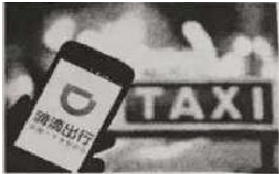
There were three big fish in the lake.One of them,Demo,was wise;another one,Jimmy,was half﹣wise;Martin,the third one,was stupid.
Some fishermen came to the bank of the lake with their nets.The three fish saw them.
Demo decided at once to leave,to make the long and difficult trip to the ocean.He thought,"I won't discuss with these two about this.They love this place so much that they call it home and will stay on.How silly they are!They still haven't realized we are in great danger now.Their ignorance will cost them their lives."
Seeing the wise fish had left,Jimmy thought,"My guide has gone and now I've lost my chance to escape."He felt sorry for it and then thought,"What can I do to save myself from these men and their nets?Perhaps I should pretend (假装)to be already dead,giving myself totally to the water."So he did that.He went up and down with the water,helpless,within arm's reach of the fishermen.
"Look at this!The best and biggest fish is dead."One of the men lifted him by the tail,and threw him up on the ground.He rolled (滚动)over and over and moved secretly toward the water,and then,back in.
The third fish was aimlessly jumping about,trying to escape with his speed and cleverness.The net,of course,finally closed around him,and as he lay in the hot frying﹣pan bed,he thought,"If I get out of this,I'll never live again in the limits of the lake.Next time,the ocean!I'll make it my home."
56.The passage is a
A.diary
B.story
C.notice
57.The underlined word"ignorance"in the passage means" "in Chinese.
A.冲动
B.勇气
C.愚昧
58.Jimmy thought that he could escape from the fishermen by .
A.traveling to the ocean
B.pretending to be dead
C.jumping here and there
59.Who was caught by the fishermen at last?
A.Demo
B.Jimmy.
C.Martin.
60.What can we learn from the passage?
A.It is important to make proper changes in time.
B.Good chances are always given to the honest.
C.The stupid can also succeed with great efforts.
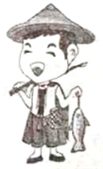
Are you good with money? Do you get pocket money from your parents or do you work to make money?Read on to find out about British teenagers and their money!
Pocket money
Most teenagers in Britain receive pocket money from their parents. They might have to do some housework to get pocket money, including cleaning, cooking, washing dishes and so on.
Part﹣time work
A part﹣time job is a choice for teenagers who don't have pocket money or who want to get extra money.About 15% teenagers have a job. Only children over the age of 13 can work. Popular part﹣time jobs for teens include babysitting, delivering( 递送) newspapers, restaurant work and shop work. Children in Briain can work two hours a day at the most on a school day but not during school hours. During weekends and school holidays, they can work longer hours.
Bank accounts (账户)
Some children and teenagers have a bank account. There is no age limit at which you can open a bank account, but a bank manager can decide whether to open an account for a child or a young person. Parents can put pocket money directly into their child's bank account. Most banks have a prepaid bank card designed for young people.
Mobile apps
Many companies have made mobile apps for children,including GoHeny,Osper and Gimi.Parents can add money to their children's accounts and check to see how the money is spent. Children can choose to save their money or spend it using a card. The apps suggest that kids from 8 to 13 can use the cards.
So, many teenagers are getting experience working part﹣time, dealing with banks and deciding whether to save or spend their money. These are all steps towards becoming a financially independent (经济独立的)person and making and looking after your own money.
(1)How can British teenagers get their pocket money?
A. By doing homework.
B. By doing housework.
C. By opening accounts.
D. By using mobile apps.
(2)To get extra money, British teenagers over 13 can .
A. work in shops two hours a day during weekends
B. help to take care of babies during school hours
C. deliver newspapers for three hours on school days
D. work in restaurants every day as long as they wish
(3)What does the author think of the bank accounts and mobile apps for children?
A. They may help parents save their children's money.
B. They may help kids learn to look after their money.
C. They might prevent children getting extra money.
D. They might get kids used to spending extra money.
(4)What is the passage mainly about?
A. How to get along well with the bank managers.
B. How to deal with bank accounts and mobile apps.
C. How British teenagers work part﹣time to make money.
D. How British teenagers make and manage their money.
" Red envelope "(微信红包)has swept the country recently.Children can get more money by snatching(抢)red envelope. But everyone needs to understand something about money: where it comes from, how to save it and how to spend it correctly. Too many parents don't take time to teach their children about money, and as a result, many of those children don't know how to deal with money when they grow up.
When should parents begin teaching their children about money? Experts(专家) agree that it's never too early. The more children learn about money,the more correctly they will be able to deal with money as they grow older. To begin with, parents can teach kids how to count money.
Next, parents can teach kids how to save money. For example, a kid wants a new bicycle. Parents can teach them to save part of their pocket money for that bike,while still keeping some money for ice cream and movies. In this way they will begin to understand the meaning of saving.
Also it's never too early to teach children different ways to make money besides snatching red envelopes. For example, they wash cars, clean gardens, look after babies and so on. Sit down with children and talk with them about some ways they could make money. You'll be surprised and glad at the effort they will begin making.
Teach children about how to deal with money when they're young, and their future will be brighter.
(1)Experts agree that parents should teach the children about money .
A. when they grow up
B. when they go to school
C. as early as possible
(2)In order to teach the children about money, parents may tell them to start with .
A. counting money
B. making money
C. saving money
(3)Parents teach kids how to save money so that the children can .
A. buy ice cream
B. know the meaning of saving
C. watch movies
(4)According to the passage, it is TRUE that .
A. parents should ask children to buy a new car
B. parents should ask children to study harder
C. parents can teach children to save part of their pocket money
(5)The best title of the passage is " ".
A. How to save money
B. How to deal with money
C. How to make money
There are millions of recipes(菜谱) hidden in the boxes and hearts of grandmother and parents. These family recipes are a special part of our family history. Some of them have been passed down from generation(一代人) to generation.
"I realized I couldn't go home every weekend for my mom's delicious dishes," says Shreya, who is about to enter university.Shreya has recently started following her mother around the kitchen,taking notes on how to make her "masala chai" and tasty kachoris.
"Those special tastes can immediately unlock a whole flood of emotions, memories and feelings of family, love, and comfort," says she.
She adds, "I am looking to the day when my kids will come to know of their grandmothers through the dishes they cooked."
But many of us find it difficult to keep the food connection with our busy life.Even if we have time,not many of us take the effort to collect and record the recipes from our grandmothers and parents. We often get a recipe on the phone and take it down quickly on a piece of paper.We just stick it onto the fridge for a week or two and forget about it as soon as the paper disappears from there.
Actually,there are simple ways to keep family recipes,Scrapbooks(剪贴薄)are easily found in the market. You can even add photos to record every detail of your memories about the recipe.With the help of some popular apps like Story Scans, recording family recipes has never been easier.What is needed is to scan(扫描) the recipes and record the story behind each of them. It can become the most meaningful work you have ever done with and for your family.
Keeping family recipes is saving and honoring our tradition so that future generations can continue to make family ties stronger. Every time you remember your loved ones, recreate one of the dishes from your collection and let the memories from the good old days comfort you. So why not gift your kids a family recipe book when they are starting a new life?
(1)Why does Shreya follow her mother around the kitchen?
A. To clean up the kitchen.
B. To note down recipes.
C. To prepare family dinners.
D. To talk about family rules.
(2)What can we learn from the passage?
A. Ways to record recipes can be easy.
B. Most people like writing recipe books.
C. Recipes have become popular with kids.
D. People often buy recipe books in the market.
(3)Which of the following would be the best title for the passage?
A. Family Recipes: Secrets of Cooking
B. Family Recipes Are at a Crossroads
C. Family Recipes: Connections to Interests
D. Family Recipes Are More than Just Recipes
"We all have suffered from the air pollution. If we don't call for an end to the firecrackers (鞭炮), the environment will get worse and worse in the future. " said Zhang Wei. He put up a notice in his neighborhood. In the notice, he called on more people to set off(引爆) fewer firecrackers during this year's Spring Festival.
Lots of parents agreed with Zhang Wei. They said that they hated the noise of firecrackers. The noise often wake up their babies easily. And the babies really needed a quiet place to have enough sleep.
More Chinese are looking forward to celebrating the holiday in greener ways. Many people decide not to set off firecrackers. They decided not to waste food. They think that the new ways are fashionable(时尚的).
"My family didn't buy firecrackers this year. Instead, we gave the money away to a charity. It's good for the environment and the charity the Internet user "Fighter" wrote on the Blog.
In my opinion, it's very important for us to celebrate our traditional festival﹣the Spring Festival. But it's more important to reduce air pollution and protect our environment. We had better express our cheerful feeling and best wishes in greener ways. We need more people like Zhang Wei or "Fighter" who uses electronic ways like QQ, Wechat or Blog. I believe more and more people will join them and our environment will get better and better.
(1)Where did Zhang Wei put up a notice?
A. In his office.
B. In the street.
C. In his neighbor hood.
D. In his house.
(2)What did many parents think of Zhang Wei's idea?
A. It was bad.
B. It was good.
C. It was not successful.
D. It was not useful.
(3)Which of the following is fashionable according to the passage?
A. Eating a lot of food.
B. Making more money.
C. Celebrating in a greener way.
D. Setting off more firecrackers.
(4)What's the best title of the passage?
A. Don't Waste Food
B. The Spring Festival Goes Green
C. Firecrackers and Noise
D. The Christmas Holiday